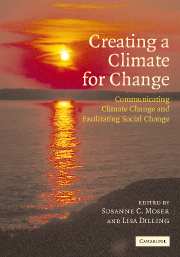Book contents
- Frontmatter
- Contents
- Preface
- Foreword
- List of contributors
- List of tables
- List of figures
- List of text boxes
- Introduction
- Part I Communicating climate change
- Part II Facilitating social change
- 15 Stuck in the slow lane of behavior change? A not-so-superhuman perspective on getting out of our cars
- 16 Consumption behavior and narratives about the good life
- 17 Educating for “intelligent environmental action” in an age of global warming
- 18 Education for global responsibility
- 19 Changing the world one household at a time: Portland's 30-day program to lose 5,000 pounds
- 20 Changing organizational ethics and practices toward climate and environment
- 21 Change in the marketplace: business leadership and communication
- 22 The market as messenger: sending the right signals
- 23 Making it easy: establishing energy efficiency and renewable energy as routine best practice
- 24 Forming networks, enabling leaders, financing action: the Cities for Climate Protection™ campaign
- 25 Ending the piecemeal approach: Santa Monica's comprehensive plan for sustainability
- 26 States leading the way on climate change action: the view from the Northeast
- 27 West Coast Governors' Global Warming Initiative: using regional partnerships to coordinate climate action
- 28 Building social movements
- 29 Climate litigation: shaping public policy and stimulating debate
- 30 The moral and political challenges of climate change
- Part III Creating a climate for change
- About the authors
- Index
- References
15 - Stuck in the slow lane of behavior change? A not-so-superhuman perspective on getting out of our cars
Published online by Cambridge University Press: 20 August 2009
- Frontmatter
- Contents
- Preface
- Foreword
- List of contributors
- List of tables
- List of figures
- List of text boxes
- Introduction
- Part I Communicating climate change
- Part II Facilitating social change
- 15 Stuck in the slow lane of behavior change? A not-so-superhuman perspective on getting out of our cars
- 16 Consumption behavior and narratives about the good life
- 17 Educating for “intelligent environmental action” in an age of global warming
- 18 Education for global responsibility
- 19 Changing the world one household at a time: Portland's 30-day program to lose 5,000 pounds
- 20 Changing organizational ethics and practices toward climate and environment
- 21 Change in the marketplace: business leadership and communication
- 22 The market as messenger: sending the right signals
- 23 Making it easy: establishing energy efficiency and renewable energy as routine best practice
- 24 Forming networks, enabling leaders, financing action: the Cities for Climate Protection™ campaign
- 25 Ending the piecemeal approach: Santa Monica's comprehensive plan for sustainability
- 26 States leading the way on climate change action: the view from the Northeast
- 27 West Coast Governors' Global Warming Initiative: using regional partnerships to coordinate climate action
- 28 Building social movements
- 29 Climate litigation: shaping public policy and stimulating debate
- 30 The moral and political challenges of climate change
- Part III Creating a climate for change
- About the authors
- Index
- References
Summary
Introduction
While riding my bike home from work during rush-hour traffic, I noticed once again that I am able to travel from Boulder's downtown to my home on the southern outskirts faster than a personal automobile. This is not because I am a superhuman on a bicycle, but because I do not have to walk far for parking and sit idly in traffic as drivers do. On this particular day, riding at a leisurely pace down the bike path, I passed the usual scene of standstill traffic and waved to several drivers. I wondered “What compels these folks to sit in traffic, especially those that also appear unhappy about their present situation?” I know my personal motives for riding a bike, including saving money on gas and parking, preservation of the environment, avoiding greenhouse gas emissions, and my physical well-being, to name a few. But why are streets backing up with cars if the highly educated people of the most “bicycle friendly and best commuting” community of Colorado – Boulder – are unhappy waiting at the stop light? And maybe more importantly, what would get them out of their stalled cars and join me on the bike path or get into public transportation?
Clearly, my daily observations are not unusual. Traffic congestion is a rapidly worsening problem in many US urban areas. And many people who already act in environmentally responsible ways wonder why others don't do so.
- Type
- Chapter
- Information
- Creating a Climate for ChangeCommunicating Climate Change and Facilitating Social Change, pp. 237 - 250Publisher: Cambridge University PressPrint publication year: 2007
References
- 3
- Cited by



